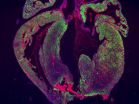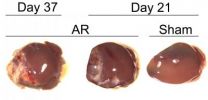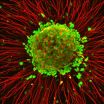(Press-News.org) The mammalian heart has generally been considered to lack the ability to repair itself after injury, but a 2011 study in newborn mice challenged this view, providing evidence for complete regeneration after resection of 10% of the apex, the lowest part of the heart. In a study published by Cell Press in Stem Cell Reports on April 3, 2014, researchers attempted to replicate these recent findings but failed to uncover any evidence of complete heart regeneration in newborn mice that underwent apex resection.
"Our results question the usefulness of the apex resection model for identifying molecular mechanisms underlying heart regeneration after damage and underscore the need for the scientific community to firmly establish whether or not the mammalian heart is capable of regeneration," says lead study author Ditte Andersen of Odense University Hospital and the University of Southern Denmark.
Cardiovascular disease is currently one of the leading causes of death worldwide, and scientists have mainly attributed this high mortality rate to the inability of the mammalian heart to regenerate after injury. Novel therapies capable of enhancing the heart's ability to recover after a heart attack or other type of injury are urgently needed. That's why a 2011 Science report from Porrello et al. that provided evidence of complete heart regeneration in newborn mice attracted a great deal of attention and raised hopes for identifying factors that could improve heart regeneration.
This study prompted Andersen, Søren Sheikh, and their colleagues to look for factors that enable heart regeneration, but they were surprised to find no signs of true heart regeneration in newborn mice that underwent apex resection. Three weeks after this procedure, the damaged hearts were about 10% shorter and weighed 14% less than the hearts of control mice that underwent the same surgical procedure without apex resection. Moreover, the damaged hearts had large scars and lacked proliferating muscle cells crucial for restoring heart function.
"The notion of mammalian heart regeneration has given a lot of hope in the scientific community for finding important factors that may be used for improving adult heart regeneration," Andersen says. "We hope that our study will add another view on this important matter and spur a lot of studies from other independent labs that may shed further light on this controversial area of research."
INFORMATION:
Stem Cell Reports, Andersen et al.: "Do neonatal mouse hearts regenerate following heart apex resection?."
New study casts doubt on heart regeneration in mammals
2014-04-03
ELSE PRESS RELEASES FROM THIS DATE:
Hummingbirds' 22-million-year-old history of remarkable change is far from complete
2014-04-03
The first comprehensive map of hummingbirds' 22-million-year-old family tree—reconstructed based on careful analysis of 284 of the world's 338 known species—tells a story of rapid and ongoing diversification. The decade-long study reported in the Cell Press journal Current Biology on April 3 also helps to explain how today's hummingbirds came to live where they do.
Part of the secret to the birds' remarkable success lies in the formation of nine principal groups or clades, hummingbirds' unique relationship to flowering plants, and the birds' continued spread into new ...
Lactase persistence alleles reveal ancestry of southern African Khoe pastoralists
2014-04-03
In a new study a team of researchers lead from Uppsala University show how lactase persistence variants tell the story about the ancestry of the Khoe people in southern Africa. The team concludes that pastoralist practices were brought to southern Africa by a small group of migrants from eastern Africa. The study is published in Current Biology today.
"This is really an exciting time for African genetics. Up until now, routes of human migration in Africa were inferred mostly based on linguistics and archaeology, now we can use genetics to test these hypotheses." says ...
Cancer and the Goldilocks effect
2014-04-03
Researchers at the University of California, San Diego School of Medicine have found that too little or too much of an enzyme called SRPK1 promotes cancer by disrupting a regulatory event critical for many fundamental cellular processes, including proliferation.
The findings are published in the current online issue of Molecular Cell.
The family of SRPK kinases was first discovered by Xiang-Dong Fu, PhD, professor in the Department of Cellular and Molecular Medicine at UC San Diego in 1994. In 2012, Fu and colleagues uncovered that SPRK1 was a key signal transducer ...
Study helps unravel the tangled origin of ALS
2014-04-03
MADISON, Wis. — By studying nerve cells that originated in patients with a severe neurological disease, a University of Wisconsin-Madison researcher has pinpointed an error in protein formation that could be the root of amyotrophic lateral sclerosis.
Also called Lou Gehrig's disease, ALS causes paralysis and death. According to the ALS Association, as many as 30,000 Americans are living with ALS.
After a genetic mutation was discovered in a small group of ALS patients, scientists transferred that gene to animals and began to search for drugs that might treat those ...
Patient stem cells help identify common problem in ALS
2014-04-03
Harvard stem cell scientists have discovered that a recently approved medication for epilepsy may possibly be a meaningful treatment for amyotrophic lateral sclerosis (ALS)—Lou Gehrig's disease, a uniformly fatal neurodegenerative disorder. The researchers are now collaborating with Massachusetts General Hospital to design an initial clinical trial testing the safety of the treatment in ALS patients.
The investigators all caution that a great deal needs to be done to assure the safety and efficacy of the treatment in ALS patients, before physicians should start offering ...
Tumor suppressor gene TP53 mutated in 90 percent of most common childhood bone tumor
2014-04-03
(MEMPHIS, Tenn. – April 3, 2014) – The St. Jude Children's Research Hospital—Washington University Pediatric Cancer Genome Project found mutations in the tumor suppressor gene TP53 in 90 percent of osteosarcomas, suggesting the alteration plays a key role early in development of the bone cancer. The research was published today online ahead of print in the journal Cell Reports.
The discovery that TP53 is altered in nearly every osteosarcoma also helps to explain a long-standing paradox in osteosarcoma treatment, which is why at standard doses radiation therapy is largely ...
ER doctors commonly miss more strokes among women, minorities and younger patients
2014-04-03
Analyzing federal health care data, a team of researchers led by a Johns Hopkins specialist concluded that doctors overlook or discount the early signs of potentially disabling strokes in tens of thousands of American each year, a large number of them visitors to emergency rooms complaining of dizziness or headaches.
The findings from the medical records review, reported online April 3 in the journal Diagnosis, show that women, minorities and people under the age of 45 who have these symptoms of stroke were significantly more likely to be misdiagnosed in the week prior ...
Jamming a protein signal forces cancer cells to devour themselves
2014-04-03
HOUSTON -- Under stress from chemotherapy or radiation, some cancer cells dodge death by consuming a bit of themselves, allowing them to essentially sleep through treatment and later awaken as tougher, resistant disease.
Interfering with a single cancer-promoting protein and its receptor can turn this resistance mechanism into lethal, runaway self-cannibalization, researchers at The University of Texas MD Anderson Cancer Center report in the journal Cell Reports.
"Prolactin is a potent growth factor for many types of cancers, including ovarian cancer," said senior author ...
Dopamine and hippocampus
2014-04-03
Montreal, April 3, 2014 – Bruno Giros, PhD, a researcher at the Douglas Mental Health University Institute and a professor in the Department of Psychiatry at McGill University, has demonstrated, for the first time, the role that dopamine plays in a region of the brain called the hippocampus. Published in Biological Psychiatry, this discovery opens the door to a better understanding of psychiatric diseases, such as schizophrenia.
Dopamine is a neurotransmitter that plays a central role in brain function, and many mental illnesses involve an imbalance in this chemical. ...
A once-only cataclysmic event and other mysteries of earth's crust and upper mantle
2014-04-03
Boulder, Colo., USA - The April 2014 Lithosphere is now available in print. Locations covered include the Acatlán Complex, Mexico; east Yilgarn craton, Australia; the eastern Paganzo basin, Argentina; the hotspot-related Yellowstone crescent, USA; and the western Alps. Locations investigated in four new papers published online on 2 April include the Banks Island assemblage in Alaska and British Columbia; The Diligencia basin of the Orocopia Mountains in California; a U.S. post-Grenville large igneous province; and South Island, New Zealand.
Abstracts are online at http://lithosphere.gsapubs.org/content/early/recent. ...




